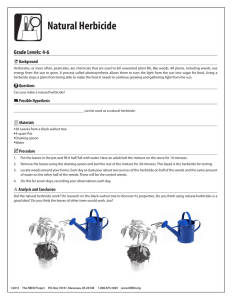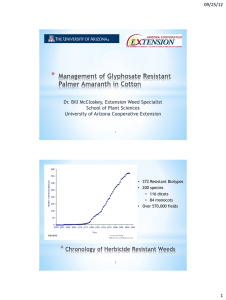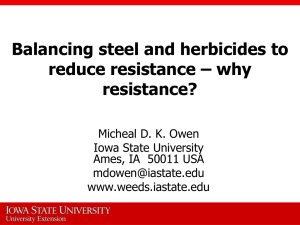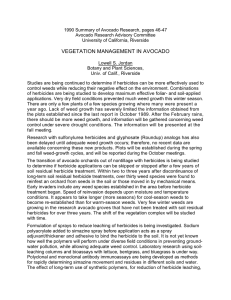William Vencill
advertisement
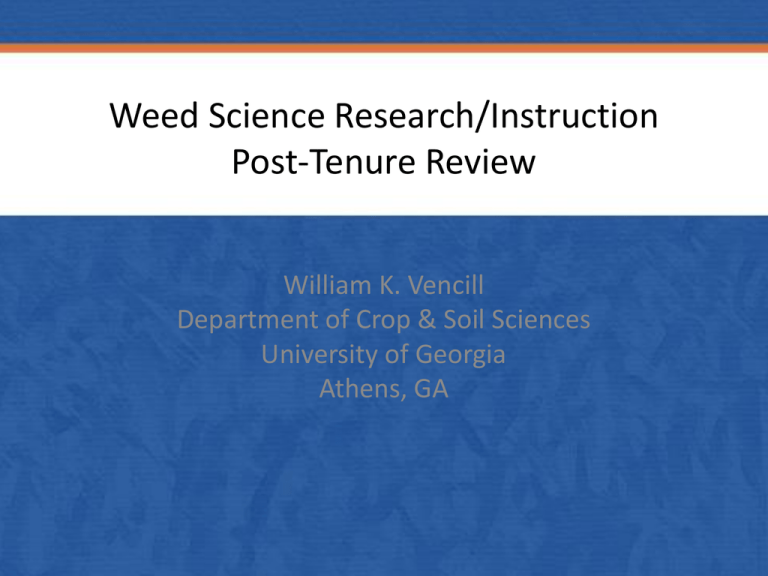
Weed Science Research/Instruction Post-Tenure Review William K. Vencill Department of Crop & Soil Sciences University of Georgia Athens, GA Background • Appointment (55% Research, 45% Instruction) • Research Areas – Herbicide Resistance – Herbicide Physiology – Herbicide Soil Interactions – Weed Management Systems in HerbicideTolerant Crops Research – Herbicide Resistance 100 % of cultivated land 80 Soybean Cotton Maize 60 40 20 0 1996 1997 1998 1999 2000 2001 2002 2003 2004 2005 2006 2007 2008 2009 2010 Year S.O. Duke: WSSA – Feb., 2011, Portland, OR Total Acres Exposed to Herbicide Sites of Action for Corn, Soybean, Cotton 140,000 Acres x 103 120,000 100,000 80,000 60,000 40,000 20,000 0 1990 1992 1994 1996 1998 2000 2002 2004 2006 DNA NASS, 2007 Acetanilides Glyphosate Triazines From Gerwick, Sept., 2010, Agrow S.O. Duke; WSSA – Feb., 2011, Portland, OR Counties with GlyphosateResistant Amaranth 200 150 100 50 0 Glyphosate Resistance • Target site resistance • Vacuolar sequestration • Overexpression EPSP target site – Does this occur in all glyphosate-resistant Palmer amaranth populations? • Do multiple mechanisms occur in some populations? EPSPS Activity in Palmer F2 Plants EPSPS Relative Copy Number and IC50 54 copies, 22 µM EPSPS Activity M Pi / g TSP / min 0.25 54, 22 M 1, 67 M 7.5, 42 M 39, 13 M 0.20 0.15 39 copies, 13 µM 0.10 7.5 copies, 42 µM 0.05 1 copy, 67 µM 0.00 0.1 PNAS, 2010 1 10 100 Glyphosate (M) 1000 10000 9 Other resistance research • • • • Triazine-Resistant Palmer Dinitroaniline-Resistant Palmer Multiple-Resistant Palmer ACCase-Resistant Large Crabgrass and Ryegrass Triazine Resistant Palmer Amaranth 0 100 1000 Atrazine (g/ha) 5000 10000 Atrazine Metabolism 1400 1200 dpm 1000 800 Susc 600 Resis Std 400 200 0 0 1 2 3 4 5 cm 6 7 8 9 Weeds with Resistance to More than one Mechanism of Action 3 4 1996 50 45 40 35 30 25 20 15 10 5 2008 2006 2004 2002 2000 1998 1992 1990 1988 1986 1984 0 1982 Source: www.weedscience.org, Ian Heap, March 2011 2 # Species with Multiple Resistance The number of weed species with resistance to more than one herbicide mechanism of action has increased drastically since 1990. Currently, 50 weed species with multiple forms of resistance have been confirmed. 1994 Resistance Mechanisms R – Non-target R – ALS Trp 574 -> Asp R – ALS Ser 653 -> Asp R – ALS Ala 122 -> Trp Susceptible ALS-Resistant Palmer Amaranth ALA122 2% TRP574 16% SER653 12% NTR 70% ALS Resistance • What are the mechanisms of the non-target site resistance? Questions about Herbicide Resistance • Why are some weeds more prone to developing resistance than others? • Why have some weeds never developed resistance even with intensive pressure? • Why are some herbicide MOA more prone to resistance development than others? Proposed Resistance Risk Classification High – ALS, ACC, PS II-T Med – EPSP, Auxin, DNA, PS I, PDS Low – VLCFA, GS a Integrated 3 2 1 3 6 9 1 (High) Single Herbicide MOA 1.5 3.0 4.5 0.5 (Mod. – Low) MOA Rotation Only 0.75 1.5 2.25 0.25 (Low) Integrated Pest Mgmta 2 4 6 1 (High) Single Herbicide MOA 1 2 3.0 0.5 (Mod. – Low) MOA Rotation Only 0.5 1 1.5 0.25 (Low) Integrated Pest Mgmt 0.5 1 3.0 1 (High) Single Herbicide MOA 0.25 0.5 1.5 0.5 (Mod. – Low) MOA Rotation Only 0.125 0.25 0.75 0.25 (Low) Integrated Pest Mgmt 1 2 3 ELEIN, Senecio, SOLXX, Salsola, Poa, DIGXX Avena, ECHCG, XANST, SORHA, SETXX, AMAXX, AMBXX, LOLXX, KOCXX, CHEAL, Conyza Blue – Highest Risk Orange – Higher Risk Yellow – Moderate Risk Green – Low Risk Pest Mgmt refers to use of all weed control tools available such as crop rotation, tillage, preventative practices, etc. Herbicide-Resistant Weeds Loss of Options Herbicide MOAs Trade Name Est. Loss of Efficacy ALS (in soybeans) Pursuit, Staple 95 % ALS (in cotton) Staple 60 % ACCase Assure, Fusilade 30 % Glycine Roundup and others 30 % Photosystem II Cotoran, Diuron 5% PPO Valor, Reflex 3% Auxin Analogs 2,4-D, Clarity (dicamba) 1% Glufosinate Liberty (Ignite) <1% Other projects • New herbicide for other crops – – – – – Pearl millet Sunflower Sweet sorghum Canola Stevia APHIS – WSSA Publications • . APHIS contracted with WSSA to have a state of the art paper written on herbicideresistance Second project contracted with APHIS to write a paper on recommendations Both papers served as foundation for National Academy of Sciences Summit on Strategies to Manage Herbicide-Resistant Weeds Weed Science Editor Editor since 2009 ~200 manuscripts/year Reduced time from submission to first response from 62 d to 45 d Teaching Teaching • Weed Science – CRSS 4340/6340 • Weed Science Lab – CRSS 4340L/6340L • Herbicide Physiology – CRSS 8330-8330L • Team teach – Pesticide Use – CRSS(ENTO)(PATH)4250 – Integrated Pest Mgmt – ENTO(CRSS) 4740/6740 – Chemical Toxicology – PHRM 8930 • First Year Odyssey Seminar Instruction-Related Accomplishments • Undergraduate Coordinator (since 1997) • College Curriculum (since 2000) Chair – 2007 and 2011 • University Curriculum (2000-2007) – General Education (2002-present) • Board of Regents Committee to reform Core Curriculum (2008) • Board of Regents Council of General Education (since 2010) • ConnectUGA Project Advisory Team (2012-2015) Awards & Honors • 2011 D.W. Brooks Faculty Award for Excellence in Teaching • 2012 – Senior Teaching Fellow Teaching – Graduate Students • In the past five years, have mentored six graduate students on a thesis program; four on a non-thesis program. • Serve as the Crop & Soil Science representative on the Master of Plant Protection Pest Management Program – On all student’s committees – Proctor an exit written exam on weed science Administrative Duties http://www.uga.edu/effectiveness/sp.html Other Administrative Duties • Supervised Office of Faculty Affairs – Promotion and tenure committees – Workshops for faculty • • • • University Program Review University System Ethics Policy Committee Budget Review SACS Leadership & Compliance Any Questions?

